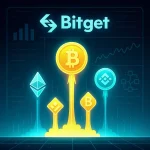Social feeds are where culture happens—but also where power concentrates. A few platforms decide who gets reach, what counts as acceptable speech, and who owns the data that makes the algorithms tick. That tension is why the question keeps returning with fresh urgency: Can Blockchain Revolutionize Social Media?
What follows is a practical, in-depth look at how blockchain and web3 social tools could reshape identity, distribution, monetization, and governance. You’ll find what’s real, what’s hype, and what’s next for decentralized social media.
The core promise of blockchain social media
- Content ownership and portability: Instead of building audience on rented land, creators can anchor content pointers and social graphs on public ledgers or decentralized storage. Your followers, your posts, and your reputation become portable across apps.
- Censorship-minimized infrastructure: Public ledgers and open protocols make it harder for a single company to erase your identity or rewrite your history. Moderation still exists—but becomes a layer you can choose, not an invisible default.
- Programmable incentives: Tokens, NFTs, and smart contracts enable native tipping, patronage, and revenue-sharing. Monetization isn’t bolted on; it’s in the protocol.
- Composability: Open social graphs let developers remix features and build new clients without starting from zero, accelerating innovation across the ecosystem.
What “on-chain social” actually looks like under the hood
- Identity and profiles: DIDs (Decentralized Identifiers), ENS handles, and protocol-native identities (e.g., Farcaster IDs, Lens profiles) replace fragile username systems. Wallet-based logins reduce reliance on email/password and SMS.
- Data storage: Posts and media rarely live fully on-chain. Instead, architectures use IPFS, Arweave, or Ceramic to store content and commit references or hashes on-chain. This balances cost, speed, and permanence.
- Protocols vs. platforms: Projects like Farcaster and Lens focus on open protocols where many clients can compete. Others use federated models like ActivityPub (Mastodon) or AT Protocol (Bluesky) to decentralize control without full blockchain dependence.
- Messaging: Decentralized messaging layers such as XMTP enable wallet-to-wallet DMs, with the promise of cross-app portability.
Monetization beyond ads
Advertising won’t disappear, but web3 social introduces native commercial primitives:
- Micropayments and tips: On-chain tipping in stablecoins or native tokens can flow directly to creators, cutting intermediaries.
- Creator coins and social tokens: Communities can issue tokens that grant perks, access, and governance rights—though designers must avoid pure speculation and focus on real utility.
- NFTs as memberships and media: Collectible content doubles as access passes to private channels, livestreams, or token-gated newsletters.
- Revenue-sharing smart contracts: Protocols can split revenue across collaborators automatically, enabling fairer creator economies.
Governance and moderation, redesigned
Moderation remains essential—but blockchain changes who decides and how:
- Client-side moderation: Instead of one universal policy, users and communities subscribe to moderation lists curated by DAOs, experts, or local leaders.
- Transparent rules: On-chain governance proposals, votes, and appeals create auditable processes instead of opaque decisions.
- Reputation systems: Composable reputation—based on verified credentials, activity, or attestations—can help elevate trusted voices and reduce spam, while preserving privacy with zero-knowledge techniques.
UX hurdles: wallets, keys, and gas
The biggest friction isn’t ideological—it’s practical:
- Key management: Seed phrases are scary. Social recovery, MPC wallets, and account abstraction reduce risk and complexity.
- Gas fees: Gasless transactions via meta-transactions or sponsored gas help users post, like, and follow without thinking about networks and fees.
- Familiar flows: Sign-in with wallet should feel as simple as OAuth. Progressive onboarding (custodial first, self-custody later) can meet mainstream users where they are.
Scalability: social is high-volume, low-value per action
Likes, follows, and replies are tiny actions at massive scale. That demands:
- L2 rollups and app-chains: Optimistic and ZK rollups move volume off L1 while preserving security guarantees.
- Data compression: Storing hashes, using content-addressed storage, and batching events keep costs manageable.
- Selective on-chain writes: Not everything belongs on-chain. Hybrid designs push non-critical data off-chain without losing auditability.
Interoperability with the broader fediverse
The social web is fragmenting into interoperable islands:
- ActivityPub/AT Protocol: Not blockchains, but decentralized. Bridges can sync identity and posts between blockchain-based graphs and federated networks.
- Open actions: Protocols like Lens and Farcaster expose “open actions” or frames that let apps call each other, creating a social OS where content is interactive and portable.
Privacy and safety
Public ledgers are transparent by default. That’s powerful—and risky—without careful design:
- End-to-end encryption for DMs and private groups.
- Zero-knowledge proofs to verify attributes (e.g., age, membership) without exposing raw data.
- Selective disclosure credentials for KYC or community gating while limiting data overexposure.
Risks and trade-offs
- Speculation and volatility: Social tokens can distract from real community value.
- Sybil attacks and spam: Token incentives attract attackers—strong reputation and rate-limiting are critical.
- Legal and regulatory complexity: Securities law, data protection, and content liability vary globally.
- Irreversibility: On-chain mistakes are permanent; good UX and safe defaults are non-negotiable.
Who’s building it
- Lens Protocol: A composable social graph where follows, posts, and collects are on-chain. Rich ecosystem of clients and tools.
- Farcaster: An open social protocol with hubs for data availability and permissionless clients. Frames make posts interactive apps.
- DeSo: A blockchain tailored for social workloads.
- Mirror: Publishing and crowdfunding tools using NFTs and splits.
- The fediverse: Mastodon and Bluesky are not purely on-chain, yet they share values of portability and user control—and can interoperate with web3 rails via bridges.
Why crypto exchanges matter to social adoption
For decentralized social media to reach the next hundred million users, people need an easy way to acquire small amounts of crypto for tips, subscriptions, and memberships. Onramps, low fees, and wide asset support are crucial. That’s where user-friendly exchanges are part of the puzzle.
If you’re exploring web3 social, set yourself up with an account and a clean onramp. I use and recommend CoinEx for straightforward registration, broad asset coverage, and fair fees. New users can register with referral code mhz7w to get started quickly and support this research.
A practical roadmap for creators, communities, and brands
1) Define your goals
– Audience portability vs. reach expansion
– Direct monetization vs. community engagement
– Governance and co-creation vs. top-down control
2) Choose your stack
– Identity: ENS/DIDs, Farcaster IDs, Lens profiles
– Data: IPFS/Arweave for media, selective on-chain pointers
– Protocol: Farcaster or Lens for open social; bridge to ActivityPub/AT Protocol as needed
3) Monetize ethically
– Start with optional tipping and collectibles; ensure perks and utility
– Consider token-gating for premium content or early access
– Use transparent splits for collaborators
4) Build safety by design
– Clear community rules and client-side filters
– Reputation and verified credentials to deter spam
– Private groups with E2EE; apply ZK checks for sensitive gates
5) Reduce friction
– Gasless onboarding where possible
– Social recovery or MPC wallets for safety
– Familiar patterns (email + wallet linking) to ease migration
6) Measure what matters
– Ownership metrics: portable followers, cross-client engagement
– Economic health: recurring support, diversity of revenue, token velocity
– Community quality: retention, contribution rates, governance participation
FAQs
- Will decentralized social replace Web2? More likely: a layered web. Open protocols will power many apps; centralized platforms will coexist, especially for highly curated experiences.
- Who pays gas for likes and follows? Most consumer apps will sponsor or batch transactions, hiding gas from end users.
- What about moderation? Expect pluralism: multiple moderation lists, transparent appeals, and choice of clients that match community norms.
- Is privacy possible on public ledgers? Yes—with E2EE for content and zero-knowledge proofs for selective disclosure.
- How do I start? Set up a wallet, claim an identity (e.g., ENS or a protocol profile), and experiment on an open social protocol. Acquire a small balance for tips via a reliable exchange like CoinEx using referral code mhz7w.
Signals to watch in 2025
- Mainstream apps integrating wallet logins and tokenized memberships
- Breakthroughs in ZK performance enabling privacy-preserving social features
- L2 throughput increases and cheaper DA solutions pushing social to the edges
- Standards for portable reputation and cross-protocol follow graphs
- Regulation clarifying tokens used as utility/access rather than speculative assets
Building an ecosystem, not just an app
The real innovation isn’t a single “crypto social network,” but a web of interoperable pieces: identity rails, storage networks, messaging layers, open graphs, and client applications competing on UX. When users can carry their communities anywhere and creators can get paid natively, incentives start to align with healthier digital public spaces.
If you’re ready to test these ideas, set up your onramp and join a protocol. Grab your account at CoinEx with referral code mhz7w, then experiment with a few creators you love: tip, collect, and track what changes when value flows directly.





